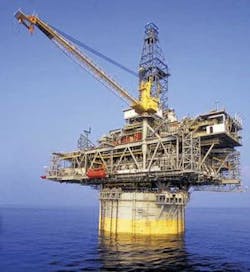First production of New Year
BP has begun oil and natural gas production from its Mad Dog development in the deepwater Gulf of Mexico, approximately 220 mi south of New Orleans, Louisiana.
BP designed Mad Dog, in 4,500 ft of water in Green Canyon block 826, to process 100,000 b/d of oil and 60 MMcf/d of gas when all the wells are completed and brought online.
The Mad Dog development consists of a truss spar equipped with facilities for simultaneous production and drilling operations. The truss spar is the first to use a permanent polyester mooring system in the GoM. HMC installed the largest-diameter polyester rope with a jacketed diameter of 270 mm. Mad Dog also required the largest quantity of polyester mooring tethers for a single offshore mooring project.
Oil from Mad Dog will travel via the Caesar pipeline to Ship Shoal block 332B, where it will interconnect with the Cameron Highway Oil Pipeline System. Mad Dog gas will move through the Cleopatra pipeline to Ship Shoal block 332A, where it will interconnect with Manta Ray Gathering System, and from there to the Nautilus Gas Transportation System into Louisiana. Both Caesar and Cleopatra pipelines are part of the BP-operated Mardi Gras Transportation System.
BP operates Mad Dog with a 60.5% working interest, BHP Billiton owns a 23.9% working interest, and Unocal owns a 15.6% working interest.
Mad Dog is one of three world-class BP-operated Gulf of Mexico deepwater developments scheduled for start-up this year and next. In addition to Mad Dog, Thunder Horse is scheduled for start-up later this year, followed by Atlantis in 2006. A fourth project, Holstein, started production in December 2004. All these fields link into the Mardi Gras Transportation System.
Offshore LNG terminal
ConocoPhillips has submitted an application to the US Coast Guard for the construction of a new offshore LNG regasification facility in the GoM. The proposed Beacon Port Clean Energy Terminal will be in federal waters 56 mi south of the Louisiana mainland.
The facility will offload, store, and regasify the LNG, then make the natural gas available through a system of pipelines for delivery. This facility will have a throughput capacity of 1.5 bcf/d and will serve as a source of clean energy for the US and the Gulf Coast region.
ConocoPhillips plans for Beacon Port to consist of two concrete gravity-based LNG storage tanks, regasification equipment, docking platforms, and other unloading and operational equipment. A separate platform adjacent to the tanks will house terminal crew and other related equipment and non-operational facilities. Beacon Port will send gas to the mainland through 46 mi of new pipeline and a riser platform that will connect to existing pipelines 29 mi south-southeast of Johnson’s Bayou, Louisiana. Existing pipelines will bring the gas to shore.
Construction could begin in late 2006 and will take four years. ConocoPhillips anticipates that the first shipment of LNG to the facility could be delivered in 2010.
Production stabilizes
This past year was marked by a 30-year high in oil imports, due in part to a record-breaking hurricane season, the Minerals Management Service reports. Oil and gas production in the GoM is expected to return to normal this year, following the devastation of Hurricane Ivan. Less than 10% of oil production and 5% of natural gas production remains shut in. MMS experts also note that approximately 98% of the major oil and gas platforms in the Gulf are producing.
“Although a high level of production has been restored, MMS will continue to monitor the ever-changing situation in the Gulf of Mexico,” MMS Regional Director Chris Oynes, says.
As of Jan. 31, approximately 135,756 b/d of oil and about 489 MMcf/d of gas remain shut in. MMS estimates that, of the approximately 4,000 structures and 33,000 mi of pipelines in the Gulf, 150 platforms and 10,000 mi of pipeline were in the direct path of Hurricane Ivan. This path brought Hurricane Ivan across the shelf and through the waters of the Mississippi River delta, the area most susceptible to underwater mudslides in the GoM.
Hurricane Ivan destroyed seven platforms and caused significant damage to 24 others, 16 of which remain off production. Of the 16 platforms that remain shut in, 14 are shelf facilities and two are deepwater facilities. With industry still conducting underwater structural damage assessments, the number of platforms with significant damage could increase. However, updated projections forecast all remaining deepwater facilities will be back online by April.
MMS identified numerous pipelines damaged by Hurricane Ivan. Mudslides damaged 13 pipelines, which remain shut in, and other forces damaged an additional four pipelines with a diameter greater than 10 in., all of which remain shut in.
MMS will conduct engineering studies to examine the structural forces that were experienced by the platforms during the hurricane. MMS has received $500,000 from Congress to contract technical studies of the impact of Hurricane Ivan.





